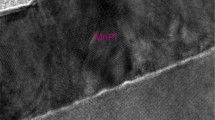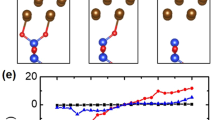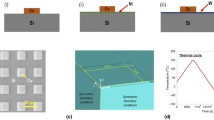Abstract
Copper solubility in low-k dielectrics has been shown to be a major factor in decreasing the useful lifetime of an interconnect. A number of groups have shown experimentally that increased surface oxygen concentration, increased moisture content in the dielectric, and an increase in interfacial copper concentration from chemical–mechanical polishing all contribute to accelerated failure. Here, we assumed that all these processes led to an increase in the solubility of metal at the SiO2/metal. We systematically varied the value of the interfacial solubility, Ce over a wide range and showed that the solubility strongly affects the distribution of copper and the local electric field within the dielectric. This changes the mechanism by which failure occurs from one where copper must penetrate all the way through the dielectric to one where copper penetration is limited to a thin layer near the surface. The solubility levels required to alter the failure mechanism, 1026–1027 atoms/m3, are within the realm of possibility and have been reported in the context of fabricating Cu-SiO2 resistive switching elements for memory applications.










Similar content being viewed by others
References
R.S. Achanta, W.N. Gill, J.L. Plawsky, G. Haase, J. Vac. Sci. Technol. 24(3), 1417 (2006)
Y. Li, I. Ciofi, L. Carbonell, N. Heylen, J. Van Aelst, M.R. Baklanov, G. Groeseneken, K. Maex, Z. Tőkei, J. Appl. Phys. 104, 034113 (2008)
D. Oshida, T. Takewaki, M. Iguchi, T. Taiji, T. Morita, Y. Tsuchiya, S. Yokogawa, H. Kunishima, H. Aizawa, N. Okada, in Proceedings of the IEEE International Interconnect Technical Conference. (2008), p. 222
R.S. Achanta, W.N. Gill, J.L. Plawsky, Appl. Phys. Lett. 91, 234106 (2007)
R.S. Achanta, W.N. Gill, J.L. Plawsky, J. Appl. Phys. 106, 074906 (2009)
R.S. Achanta, W.N. Gill, J.L. Plawsky, J. Micro/Nanolithography, MEMS, and MOEMS 9, 041104 (2010)
D.J. Di Maria, J.W. Stasik, J. Appl. Phys. 65, 2342 (1989)
S. Lombardo, J.H. Stathis, B.P. Linder, K.L. Pey, F. Palumbo, C.H. Tung, J. Apply. Phys. 98, 12301 (2005)
J.M. Atkin, E. Cartier, T.M. Shaw, J.R. Lloyd, R.B. Laibowitz, T.F. Heinz, Microelectron. Engg. 86, 1891 (2009)
J.R. Lloyd, C.E. Murray, S. Ponoth, S. Cohen, E.G. Liniger, Microlectron. Reliab. 46, 1643 (2006)
R. Gonella, Microlectron. Engg. 55, 245 (2001)
A.L.S. Loke, J.T. Wetzel, P.H. Townsend, T. Tanabe, R.N. Vrtis, M.P. Zussman, D.K. Kumar, C. Ryu, S.S. Wong, IEEE Trans. Electron. Devices 46, 2178 (1999)
K.L. Jensen, J. Vac. Sci. Technol. B 21, 1528 (2003)
I.S. Savinov, Semiconductors 39, 591 (2005)
M.V. Fischetti, Phys. Rev. B 31, 2099 (1985)
G.S. Haase, E.T. Ogawa, J.W. McPherson, J. Lloyd (ed.), in Proceedings, 43rd Annual Reliability Physics Symposium (IEEE, New York, 2005), p. 466
J.W. McPherson, H.C. Mogul, J. Appl. Phys. 84, 1513 (1998)
G.S. Haase, J. Appl. Phys. 105, 044908 (2009)
F. Chen et al., in J. Lloyd (ed.), in Proceedings, 43rd Annual Reliability Physics Symposium, IEEE International (New York, April 17–21, 2005), p. 501
N. Suzumura, S. Yamamoto, D. Kodama, K. Makabe, J. Komori, E. Murakami, S. Maegawa, K. Kubota, C. Grass (ed.), in Proceedings, 44th Annual Reliability Physics Symposium, IEEE International (New York, March 26–30, 2006), p. 484
V.P. Romanov, Phys. Stat. Sol. A 70, 525 (1982)
V.P. Romanov, Yu.A. Chaplygin, Phys. Stat. Sol. A 53, 493 (1979)
Y. Shacham-Diamand, A. Dedhla, D. Hofstetter, W.G. Oldham, J. Electrochem. Soc. 140, 2427 (1993)
S.-S. Hwang, S.-Y. Jung, Y.-C. Joo, J. Appl. Phys. 101, 074501 (2007)
S.P. Thermaden, S.K. Bhagat, T.L. Alford, Y. Sakaguchi, M.N. Kozicki, M. Mitova, Thin Solid Films 518, 3292 (2010)
Acknowledgments
We acknowledge the Semiconductor Research Corporation and NYSTAR for funding this work.
Author information
Authors and Affiliations
Corresponding author
Rights and permissions
About this article
Cite this article
Plawsky, J.L., Gill, W.N. & Achanta, R.S. Impact of interfacial solubility on penetration of metals into dielectrics and the mechanism of failure. J Mater Sci: Mater Electron 23, 48–55 (2012). https://doi.org/10.1007/s10854-011-0406-x
Received:
Accepted:
Published:
Issue Date:
DOI: https://doi.org/10.1007/s10854-011-0406-x




